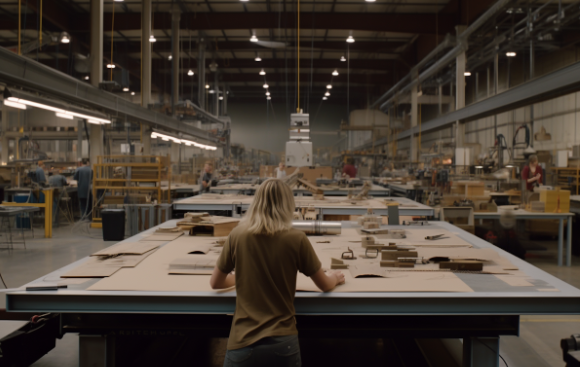“No. 8 Will Shock you!”
Introduction
Running a manufacturing business or workshop is tough. Between managing employees, keeping up with orders, and making sure no one turns your shop floor into a reality TV-worthy disaster, energy costs are probably the last thing on your mind. But here’s the kicker—your energy bill is silently eating away at your profits, and you might not even realize it!
Did you know that industrial facilities account for nearly 30% of total energy consumption in the U.S.? (source) That’s a staggering number, and if your shop isn’t optimized for efficiency, you could be wasting thousands of dollars every year.
But don’t worry! We’ve got you covered with the best Manufacturing and Workshop energy saving tips that will help you cut down waste, reduce costs, and keep your operations running efficiently. Buckle up—because No. 8 is going to blow your mind!
1. The Hidden Costs of Energy in Manufacturing and Workshops
Most business owners assume their machines only use power when they’re running. Surprise! Even idle equipment, inefficient processes, and tiny leaks can cost you big time.
How Much Energy Are You Really Using?
- The average U.S. manufacturing plant spends $6.7 billion annually on electricity (source).
- Phantom energy use (power consumed when equipment is off but still plugged in) can account for 10% of total electricity costs.
- The biggest offenders? Air compressors, old motors, and poor HVAC systems.
Solution? Conduct an energy audit (many power companies offer free or subsidized ones). Knowing where your power is going is the first step toward saving money.
2. Air Compressors: The Silent Energy Hog
Your air compressor is like that one friend who “just needs a little help moving” and ends up making you haul furniture for six hours. It looks harmless but consumes more energy than you think!
How to Reduce Air Compressor Energy Waste:
- Fix leaks – Up to 30% of compressed air is wasted due to leaks.
- Optimize pressure settings – Running at higher pressure than needed wastes energy.
- Use Variable Speed Drive (VSD) compressors – These adjust power use based on demand, cutting costs by up to 50%.
- Turn it off – Don’t leave compressors running when not in use.
💡 Case Study: A Texas-based auto repair shop cut 20% off their energy bill just by fixing air compressor leaks and lowering pressure settings!
3. Power Tools and Machinery: The Unnoticed Energy Drain
Whether it’s a table saw, CNC machine, or a lathe, your power tools don’t need to be guzzling electricity 24/7.
Ways to Cut Energy Waste:
- Use high-efficiency motors (IE3 or IE4-rated) – These save 15-30% more energy than standard motors.
- Install regenerative braking – Especially for CNC machines, this reuses energy instead of wasting it.
- Turn off machines when idle – Sounds obvious, but so many businesses leave tools running unnecessarily.
- Smart scheduling – Run heavy machinery during off-peak hours when electricity rates are lower.
🔧 Example: A small furniture manufacturer in California saved $12,000 per year by upgrading to energy-efficient motors and shutting down idle machinery.
4. Welding Equipment: The High-Voltage Culprit
Welding tools require high amounts of electricity, but with a few tweaks, you can slash their energy use.
Energy-Saving Welding Tips:
- Use inverter-based welders – They consume 50% less power than traditional transformers.
- Reduce idle time – Train employees to turn off welders when not in use.
- Use power factor correction devices – They reduce wasted electricity and lower costs.
- Switch to pulsed welding – Uses short bursts of energy instead of continuous flow, cutting power use.
🔥 Fun Fact: Some modern welding machines can cut energy use by half while still producing the same output. Time for an upgrade?
5. Heating and Cooling Systems: The Overlooked Cost Factor
Workshops can get HOT. But cooling (or heating) inefficiently is a money pit.
Ways to Save on HVAC Costs:
- Use programmable thermostats – Set schedules to avoid heating/cooling empty spaces.
- Install industrial fans – They improve air circulation and reduce HVAC strain.
- Regularly clean air filters – Dirty filters increase energy use by up to 15%.
- Seal leaks in doors and windows – Prevents wasted heating/cooling.
🏭 Example: A manufacturing plant in Florida reduced cooling costs by 30% just by installing smart thermostats and sealing leaks.
6. Industrial Lighting: Shedding Light on Energy Waste
Still using fluorescent or halogen lights? Time for an upgrade!
Lighting Efficiency Hacks:
- Switch to LED bulbs – Uses 75% less energy and lasts 25x longer.
- Install motion sensors – Automatically turns off lights when areas are unoccupied.
- Use daylight harvesting – Maximizes natural light to reduce artificial lighting needs.
💡 Fact: Businesses that switch to LED lighting cut their lighting costs by up to 60%.
7. Phantom Loads: The Energy You’re Paying for Without Knowing
Did you know that even when “off,” devices like chargers, idle machines, and standby electronics still use power?
How to Eliminate Phantom Loads:
- Use smart power strips – Automatically cut power to idle devices.
- Unplug non-essential equipment after hours.
- Use automatic shutdown features on office electronics.
🔌 Example: A machine shop saved $3,000 annually just by installing smart power strips and reducing phantom loads.
8. The Shocking Energy Waster Most Business Owners Ignore!
🔴 Surprise! Your compressed air system might be your biggest energy waster!
A poorly maintained compressed air system can waste more electricity than all your lights and tools combined. A single 1/8-inch hole in your air lines could cost you over $1,200 a year in wasted electricity.
Solution? Fix leaks, optimize pressure, and use VSD compressors.
9. Employee Training: The Human Factor in Energy Efficiency
Your employees can be your best energy-saving asset—if trained properly.
Ways to Engage Employees in Energy Conservation:
- Offer incentives for energy-efficient behavior.
- Post reminders in key areas.
- Assign energy efficiency champions to oversee savings efforts.
10. Renewable Energy: The Future of Manufacturing and Workshops
Going green isn’t just good for the planet—it’s great for your wallet.
How to Incorporate Green Energy:
- Install solar panels – Cuts electricity costs by 50% over time.
- Check for government incentives for renewable energy adoption.
- Switch to a green energy provider like Chariot Energy
🌞 Example: A Texas-based metal shop cut 40% off its energy bill by installing solar panels and switching to a renewable energy provider.
Conclusion
Cutting down on energy waste doesn’t have to be complicated. Follow these Manufacturing and Workshop energy saving tips, and you’ll save money, improve efficiency, and reduce your environmental impact.
Ready to make a change? Check out Chariot Energy for affordable, sustainable energy solutions tailored to businesses like yours!

